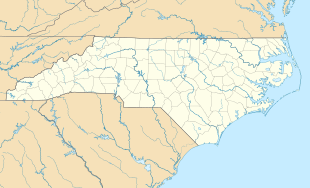Fort Dobbs | |
 Detail of a 1770 map of North Carolina by John Collett depicting the locations of Fort Dobbs, the Yadkin and Catawba Rivers, and Salisbury.[2] | |
| Nearest city | Statesville, North Carolina |
|---|---|
| Coordinates | 35°49′18″N 80°53′42″W / 35.82167°N 80.89500°W |
| Area | 9.5 acres (3.8 ha; 0.0148 sq mi) |
| Built | 1755–1756 |
| Architect | Arthur Dobbs, Hugh Waddell |
| Architectural style | Log blockhouse |
| MPS | Iredell County MRA (AD) |
| NRHP reference No. | 70000458[1] |
| Added to NRHP | September 15, 1970 |
Fort Dobbs was an 18th-century fort in the Yadkin–Pee Dee River Basin region of the Province of North Carolina, near what is now Statesville in Iredell County. Used for frontier defense during and after the French and Indian War, the fort was built to protect the American settlers of the western frontier of North Carolina, and served as a vital outpost for soldiers. Fort Dobbs' primary structure was a blockhouse with log walls, surrounded by a shallow ditch, and by 1759, a palisade. It was intended to provide protection from French-allied Native Americans such as the Shawnee raids into western North Carolina.
The fort's name honored Arthur Dobbs, the Royal Governor of North Carolina from 1755 to 1765, who played a role in designing the fort and authorized its construction. Between 1756 and 1761, the fort was garrisoned by a variable number of soldiers, many of whom were sent to fight in Pennsylvania and the Ohio River Valley during the French and Indian War. On February 27, 1760, the fort was the site of an engagement between Cherokee warriors and Provincial soldiers that ended in a victory for the Provincials.
Fort Dobbs was abandoned in March, 1761, and disappeared from the landscape. Archaeology and historical research led to the discovery of the fort's exact location and probable appearance. The site on which the fort sat is now operated by North Carolina's Division of State Historic Sites and Properties as Fort Dobbs State Historic Site. The reconstruction of the fort was completed on September 21, 2019.[3]
- ^ "National Register Information System". National Register of Historic Places. National Park Service. July 9, 2010.
- ^ "A Compleat map of North Carolina from an actual survey". North Carolina Maps. UNC Digital Collections. Retrieved December 31, 2012.
- ^ "Grand Opening of Fort Dobbs". fortdobbs.org. Retrieved September 24, 2019.


